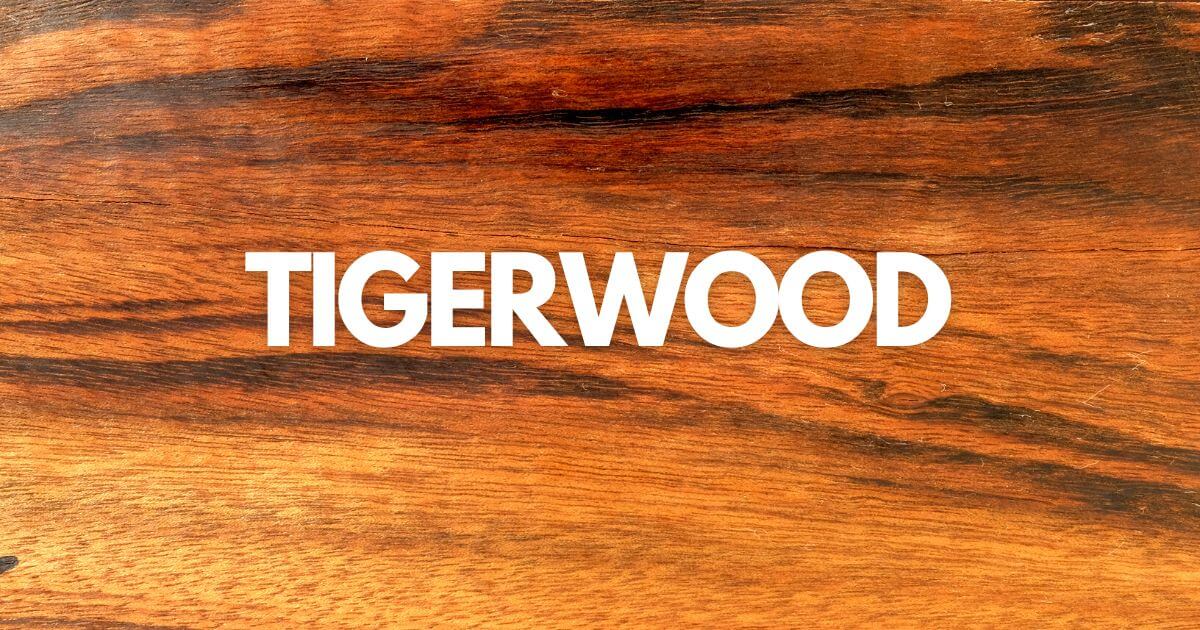Tigerwood is a very durable, dense, and weather-resistant hardwood species native from Mexico southward to Brazil. It is famous for many characteristics, but one of them is its unique and beautiful texture.
The scientific name of tigerwood is Astronium fraxinifolium, also known as Goncalo Alves, Jobillo.
Tigerwood gets its name from the unique blend of reddish-brown and black stripes similar to a tiger’s stripes.
| # | Tigerwood |
| Tree Height | 100′-130′ in height, 3′-5′ in diameter |
| Dried Weight | 57 lbs/ft3 (905 kg/m3) |
| Janka Hardness | 2,170 lbf (9,640 N) |
| Wood Color | Reddish brown |
| Crushing Strength | 10,770 lbf/in2 (74.2 MPa) |
| Odor | No Odor |
Tigerwood uses
Tigerwood is most commonly used for furniture, cabinetry, carving, archery bows, tools, gun handles, etc., but it is most widely used for flooring.
Tigerwood is a versatile wood that can be used for many applications. It can be used for both exterior and interior purposes.
Tigerwood Appearance and Color
There are orange and black stripes on the Tigerwood which looks very beautiful. Generally, the color of the wood is medium reddish brown. Tigerwood may have straight or wavy, or interlocked grain patterns. Like many other hardwoods, Tigerwood darkens over time.
Advantages and Disadvantages of Tigerwood
Advantages
Extreme Durable
Tigerwood is highly durable wood resistant to rot, decay, and insect infestation. Which makes it an excellent choice for all types of applications.
Weather Resistant
Tigerwood is naturally dense and contains natural oils that prevent it from absorbing water or moisture. Tigerwood can withstand extreme weather and is also famous for outdoor furniture.
Easy to Maintain
Tigerwood is naturally strong and stable, so it does not require as much care or maintenance as other woods.
Appearance
Tigerwood has an excellent appearance which makes it different from other woods. Due to its appearance, it is famous for furniture and flooring.
Less Expensive
Tigerwood is moderately expensive but cheaper than ipe and teak hardwoods. So it is an excellent option for affordable, durable flooring.
Sustainability
Tigerwood is a sustainable and eco-friendly option for furniture. It comes from a well-maintained forest. It is not listed in the CITES Appendices or on the IUCN Red list.
Disadvantages
Hard to Work
Tigerwood is difficult to work with, which is why it takes a long time. Due to the higher density and weight, sharper tools and more resources are used.
Change Color
Tigerwood darkens over time when exposed to UV rays and sunlight. As the wood ages, its color shades, with some areas appearing lighter or darker than others.
Working with Tigerwood
Generally, Tigerwood is not difficult to work with, but high density and irregular grain can be tricky for beginners in machining. Tigerwood does not absorb any liquid quickly, so it does not accept stains, so glue properly. By the way, Tigerwood gives excellent results after finishing.
The hardness of Tigerwood
Tigerwood is very hard, and the Janka hardness value is 2,170 lbf (9,640 N). It is harder than many hardwoods and more resistant to wear and damage. Its toughness makes it suitable for flooring.
Here are other popular wood Janka hardness values to give you an idea of how hard Tigerwood is.
| Wood Species | Janka Hardness |
| Gaboon Ebony | 3,080 lbf (13,700 N) |
| Cocobolo | 2,960 lbf (14,140 N) |
| Honey Mesquite | 2,340 lbf (10,410 N) |
| Tigerwood | 2,170 lbf (9,640 N) |
| Wenge Wood | 1,930 lbf (8,600 N) |
| Shagbark Hickory | 1,880 lbf (8,360 N) |
| Merbau | 1,840 lbf (7,620 N) |
| Pecan Wood | 1,820 lbf (8,100 N) |
| Honey Locust | 1,580 lbf (7,030 N) |
| Sweet Birch | 1,470 lbf (6,540 N) |
| Hard maple | 1,450 lbf (6,450 N) |
| Sapele | 1,410 lbf (6,280 N) |
Cost
Tigerwood can cost $8 to $15 per linear foot per board, but wood’s price depends on many factors such as size, quality, and native place.
Difference between Tigerwood and Cocobolo Wood
Cocobolo and Tigerwood are excellent hardwoods, widely used for all types of furniture and construction. Along with similarities, they also have differences.
Cocobolo is denser, more durable, and more resistant to decay and rot than Tigerwood. The natural oils in Cocobolo give it good resistance to rot, rot, and moisture.
Cocobolo is one of the world’s most expensive and rarest wood species, while Tigerwood is available at a moderate price.
The difference in Hardness between Tigerwood and Cocobolo Wood
Cocobolo is harder and heavier than Tigerwood. Tigerwood has a Janka hardness value of 2,170 lbf (9,640 N), while Cocobolo has 2,960 lbf (14,140 N).
FAQ
Is Tigerwood Fire-Resistant?
Yes, Tigerwood is a good fire resistant, preventing or slowing the fire’s spreading. Compared to other hardwoods, Tigerwood does not burn quickly.
Is Tigerwood Water-Proof?
Tigerwood is excellent moisture resistant because it naturally contains chemical compounds (or oils) that prevent it from absorbing water and leaving the surface shiny or oily. Tigerwood can withstand moisture for a long time as compared to other hardwoods.
But Tigerwood can rot and decay if overexposed to moisture with any exterior finishing.
Is Tigerwood Good for Decking and Flooring?
Tigerwood can be a great option if you plan for affordable but durable and stable Decking and Flooring. Due to its high density, it is less prone to scratches and dents.
Is Tigerwood Termite Resistant?
Merbau wood is naturally resistant to most termites because of the presence of a complex chemical compound or oil in the wood.
Conclusion
In conclusion, Tigerwood is known for its strength, durability, rot-resistant properties, and unique striped appearance. Tigerwood is famous for making high-quality decking, flooring, and furniture.
What’s the Difference Between Tigerwood and Ipe Wood?

